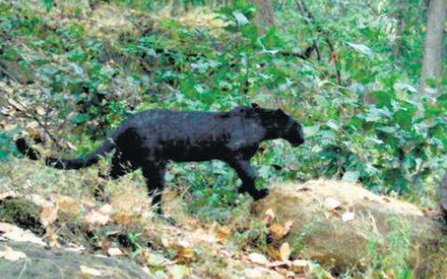Odisha’s forest officials have made a remarkable discovery during the “All Odisha Leopard Estimation” survey—the presence of rare melanistic leopards, commonly known as black panthers, in three distinct forest areas of the state. Conducted across 47 forest divisions, this extensive survey has brought new attention to these elusive creatures, offering insight into both their rarity and the need for heightened conservation efforts.
What is a Melanistic Leopard?
A melanistic leopard, often called a black panther, is not a different species but a color variation of the common leopard (Panthera pardus). This unique coloration is due to a genetic mutation that causes an overproduction of melanin, making the leopard’s fur appear black. Despite this, the iconic rosette patterns of leopards are still visible in certain lighting conditions. These black panthers are particularly rare, comprising only about 11% of the global leopard population, and are better adapted to thrive in dense forest habitats where their dark coats offer superior camouflage.
Significance of the Black Panther Sighting
The discovery of black panthers in Odisha is a significant conservation milestone, as these rare creatures face distinct challenges in survival. Their rarity, combined with threats like poaching, makes them particularly vulnerable. To protect them, authorities have kept the exact locations of the melanistic leopards secret. This ensures they remain undisturbed by human interference and shielded from illegal wildlife trade, which continues to be a major problem in the region.
Odisha’s Current Leopard Population
Odisha’s forests are home to a growing population of leopards, with the recent survey reporting a total of 696 leopards across the state—an increase of 128 from previous counts. Despite this positive trend, the current population is still lower than the 760 leopards reported in a 2018 survey by the National Tiger Conservation Authority (NTCA).
How Was the Population Estimated?
Odisha’s forest department took a meticulous approach to estimating the leopard population. They relied on traditional tracking methods such as analyzing paw prints (pugmarks), droppings (scats), and vocalizations, along with modern technology like camera traps to capture photographic evidence of the leopards. In contrast, the NTCA’s 2018 survey relied more heavily on statistical modeling, which led to a higher error margin of 35%. Odisha’s more rigorous methodology produced a more accurate count with an error margin of less than 10%, making it a reliable assessment.
Key Habitats for Leopards in Odisha
The Similipal Tiger Reserve stands out as the most important habitat for leopards and Royal Bengal Tigers in Odisha. It continues to serve as a crucial area for leopard conservation. The Satkosia landscape also demonstrated a growing population of leopards, making it the second-largest habitat for these majestic animals in the state. These areas, rich in biodiversity, are vital to the ongoing efforts to protect and expand leopard populations in Odisha.
Conservation Challenges and the Threat of Poaching
While the growing leopard population in Odisha is encouraging, poaching remains a serious concern. Between 2018 and 2023, authorities seized 59 leopard skins in the state, underscoring the persistent threat of illegal wildlife trade. Despite stringent laws and increased monitoring, poaching continues to undermine conservation efforts, particularly in regions where leopards are still targeted for their skins and other body parts.
A Call for Continuous Conservation Efforts
The discovery of black panthers, along with the overall increase in leopard numbers, highlights the importance of continued and enhanced conservation efforts in Odisha. Protecting these rare creatures requires not only safeguarding their habitats but also strengthening anti-poaching measures and raising awareness about the importance of biodiversity conservation. By prioritizing these efforts, Odisha can ensure the long-term survival of its leopards, including the melanistic variants, and contribute to the broader goal of wildlife preservation in India.
The sighting of black panthers in Odisha offers a rare glimpse into the richness of the state’s wildlife and underscores the need for sustained action to protect these extraordinary animals for future generations.


